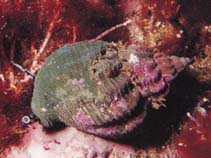Buccinum undatum Linnaeus, 1758
Waved whelk| Native range | All suitable habitat | Point map | Year 2050 |

|
| This map was computer-generated and has not yet been reviewed. |
| Buccinum undatum AquaMaps Data sources: GBIF OBIS |
Classification / Names Tên thường gặp | Các synonym ( Các tên trùng) | CoL | ITIS | WoRMS
Gastropoda | Neogastropoda | Buccinidae
Environment: milieu / climate zone / Mức độ sâu / distribution range Sinh thái học
; Mức độ sâu 0 - 600 m (Tài liệu tham khảo 78657). Temperate, preferred 11°C (Tài liệu tham khảo 107945); 85°N - 36°N, 110°W - 45°E
Distribution Các nước | Các khu vực của FAO | Các hệ sinh thái | Những lần xuất hiện | Những chỉ dẫn
Arctic, Northern Atlantic and the Mediterranean: Canadian Arctic Archipelago and the Atlantic Ocean. Temperate to polar climates.
Length at first maturity / Bộ gần gũi / Weight / Age
Chín muồi sinh dục: Lm ?, range 5 - 7.2 cm Max length : 10.2 cm SHL con đực/không giới tính; (Tài liệu tham khảo 360); common length : 5.1 cm SHL con đực/không giới tính; (Tài liệu tham khảo 360)
Short description Hình thái học
Life cycle and mating behavior Chín muồi sinh dục | Sự tái sinh sản | Đẻ trứng | Eggs | Sự sinh sản | Larvae
Main reference
Các tài liệu tham khảo | Người điều phối | Người cộng tác
Harms, J. 1993 Check list of species (algae, invertebrates and vertebrates) found in the vicinity of the island of Helgoland (North Sea, German Bight) - a review of recent records. Helgoländer Meeresunters 47:1-34. (Tài liệu tham khảo 2711)
IUCN Red List Status
(Tài liệu tham khảo 130435: Version 2025-1)
CITES status (Tài liệu tham khảo 108899)
CMS (Tài liệu tham khảo 116361)
Threat to humans
Human uses
Các nghề cá: Tính thương mại
FAO - Các nghề cá: landings, species profile | FishSource | Biển chung quanh ta
Các công cụ
Thêm thông tin
Max. ages / sizes
Length-weight rel.
Length-length rel.
Length-frequencies
Mass conversion
Sự phong phú
Các nguồn internet
BHL | BOLD Systems | CISTI | DiscoverLife | FAO(Các nghề cá: species profile; publication : search) | Fishipedia | GenBank (genome, nucleotide) | GloBI | Gomexsi | Google Books | Google Scholar | Google | PubMed | Cây Đời sống | Wikipedia (Go, tìm) | Tạp chí Zoological Record



